6 Garden Ideas for Creating a Labyrinth
Picture yourself walking along a winding stone path, where fragrant herbs brush against your ankles and tall grasses sway in the gentle breeze. You can transform your garden into a mesmerizing labyrinth that offers both visual beauty and spiritual tranquility. Whether you’re working with a spacious lawn or a modest patio, you’ll discover that creating your own meditative maze isn’t as complex as it might seem. Let’s explore six inspiring approaches that’ll help you design a peaceful sanctuary in your own backyard.
Contents
Choosing the Right Location and Size
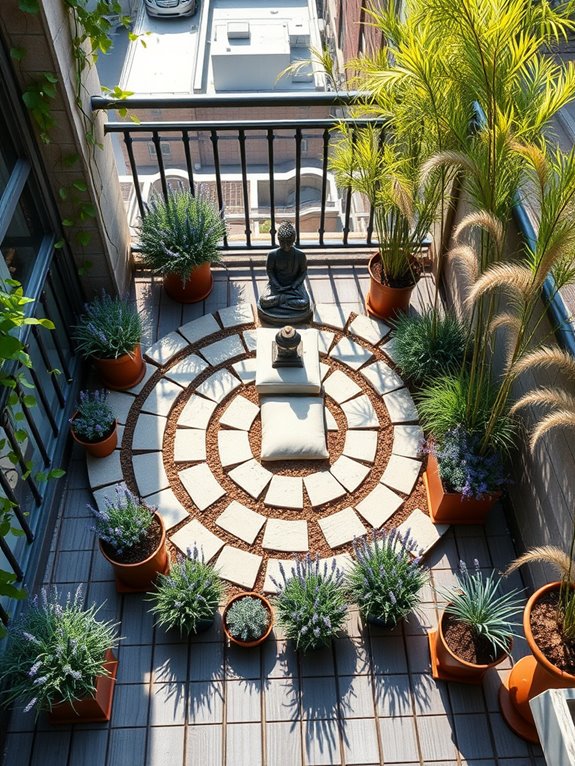
The perfect labyrinth location transforms an ordinary garden space into a meditative sanctuary, where winding paths lead visitors through a journey of self-discovery. Sunlight filtering through carefully positioned trees creates dancing shadows across stone-lined pathways, while the surrounding landscape offers both protection and privacy.
Whether nestled in a quiet corner of your backyard or commanding center stage in a sprawling garden, the labyrinth’s location sets the tone for this ancient contemplative practice.
Native grasses and low-growing herbs define the labyrinth’s boundaries, their gentle movement in the breeze adding a dynamic element to the sacred geometry. Lavender, thyme, and chamomile release calming fragrances when brushed against, while ornamental grasses like feather reed and blue fescue create subtle height variations that guide the eye along the path without overwhelming the space’s peaceful atmosphere.
Essential Elements:
- Level ground or terraced surface
- Clear sight lines
- Adequate drainage
- Natural privacy screening
- Even sunlight exposure
- Easy access point
- Sufficient walking space (minimum 15-foot diameter)
- Permeable ground surface
- Path markers or edging materials
- Center focal point
Begin by selecting a location that receives balanced sunlight throughout the day and offers natural drainage. The space should be level or capable of being leveled, with enough room to accommodate your chosen labyrinth pattern plus a buffer zone of at least three feet around the perimeter.
Consider the walking path width – typically 24 to 36 inches – when calculating the total space needed. A classical seven-circuit labyrinth requires approximately 25 feet in diameter, while smaller spaces can accommodate three- or five-circuit designs.
The soil should be properly prepared by removing existing vegetation, establishing proper drainage, and creating a firm, level surface. Install landscape fabric to prevent weed growth, followed by your chosen path material.
Traditional materials include gravel, decomposed granite, or flat stones for the walking path, with plants or permanent markers defining the boundaries between paths.
Space limitations can be creatively addressed by scaling down the design or choosing alternative patterns. For smaller gardens or balconies, consider a three-circuit design or create a finger labyrinth using container plants and decorative stones.
The path width can be reduced to 18 inches for intimate spaces, though maintain enough room for comfortable walking. Urban gardeners might opt for painted designs on decking or temporary installations using potted plants that can be easily rearranged.
Materials and Design Options
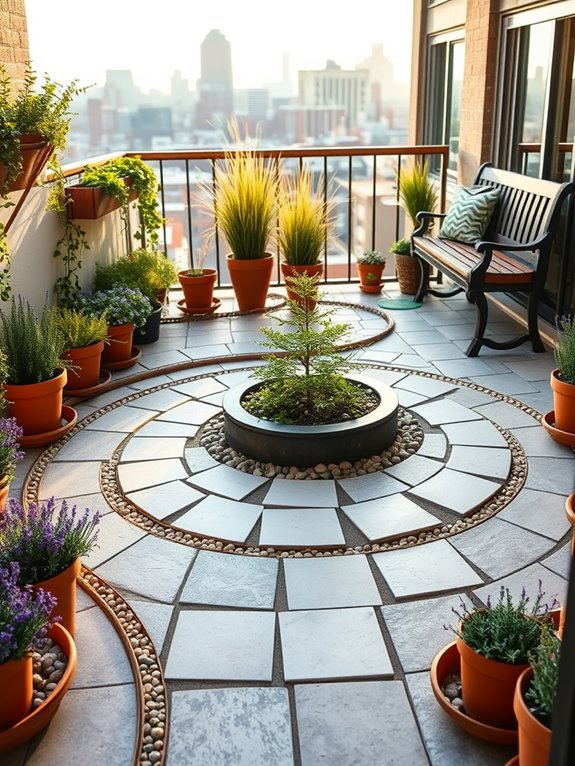
A labyrinth garden‘s materials and design options blend natural elements with intentional pathways, creating a meditative journey through carefully chosen surfaces and borders. Smooth river stones line curved paths while crushed granite or fine gravel creates a satisfying crunch underfoot.
Traditional designs incorporate low-growing herbs like thyme or chamomile between pathway stones, while modern interpretations might feature sustainable materials like recycled brick or locally sourced flagstone bordered by ornamental grasses.
The pathways wind between beds filled with lavender, sage, and rosemary, offering both visual and aromatic appeal while maintaining clear sight lines throughout the journey. Architectural elements like stone pillars or wooden archways mark significant turns or transitions, while carefully placed benches provide rest spots for contemplation.
The combination of hard and soft materials creates a balanced environment that feels both structured and organic.
Key Elements:
- Pathway materials (gravel, stone, brick, or pavers)
- Border materials (stone edging, metal edging, or wood)
- Ground cover plants
- Marker stones or posts
- Directional elements
- Seating areas
- Focal points
- Lighting fixtures
- Drainage materials
- Center piece or destination point
Implementation begins with careful planning of the labyrinth pattern, typically starting from the center and working outward. Mark the basic pattern using spray paint or rope, then install edge materials to define permanent boundaries. Layer base materials for proper drainage, followed by the chosen pathway surface.
Install lighting conduit before finalizing surface materials if desired.
Plant selection and placement should consider growth patterns and maintenance requirements. Choose specimens that won’t overgrow path edges or require excessive pruning.
Consider incorporating irrigation systems during the initial installation phase, ensuring all areas receive adequate water without creating soggy spots or erosion issues.
Design adaptations can accommodate various space constraints by scaling the pattern accordingly. Smaller spaces might focus on a simplified classical design using minimal materials, while larger areas can incorporate multiple paths and elaborate plantings.
Consider vertical elements like climbing vines or wall-mounted features to maximize limited space, and select materials that complement existing architecture and landscape elements.
For balcony installations, lightweight materials and container-friendly plants become essential, with possible use of interlocking tiles or artificial turf to create the labyrinth pattern without adding excessive weight.
Planning Your Labyrinth Pattern
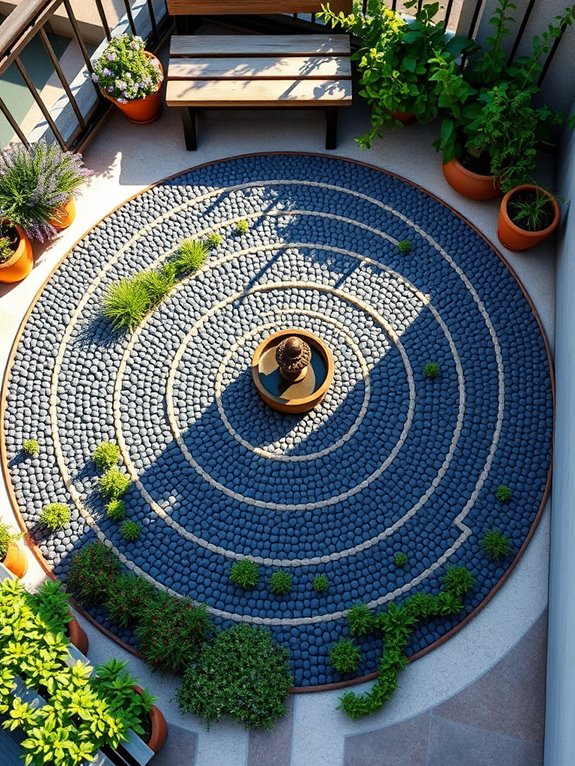
The ancient art of labyrinth design brings a mystical, meditative quality to any garden space. Whether created with neatly trimmed boxwood hedges, carefully laid stone paths, or simple gravel walkways bordered by aromatic herbs, a labyrinth pattern transforms an ordinary garden into a peaceful sanctuary. The winding paths, punctuated by thoughtfully placed benches or meditation stones, create an engaging journey that encourages mindful walking and contemplation.
The pattern itself becomes a living masterpiece when enhanced with varying heights of plantings and strategic focal points. Tall ornamental grasses like Miscanthus or Pennisetum can mark turning points, while low-growing thyme or creeping Jenny softens path edges. Consider incorporating vertical elements like sculpted topiaries or ornamental pillars at key positions to draw the eye through the curves, creating a sense of mystery and invitation to explore further.
Key Elements:
- Graph paper and measuring tools for pattern planning
- Center point marker or focal feature
- Path material (gravel, stone, or mulch)
- Border plants or hedging materials
- Entrance marker or gateway feature
- Directional stones or path markers
- Seating elements
- Lighting fixtures
- Edge restraints or path borders
Creating a labyrinth pattern begins with selecting the basic design – classical seven-circuit, medieval eleven-circuit, or contemporary adaptation. Mark the center point of your designated space and work outward, using stakes and string to outline the basic path structure. Traditional labyrinths follow a mathematical progression, with paths typically measuring between 24 to 36 inches wide to accommodate comfortable walking.
Ensure turns are gentle and flowing, avoiding sharp angles that disrupt the meditative walking experience. When designing your labyrinth pattern, consider scale adaptations based on available space. Smaller gardens can utilize simplified patterns with fewer circuits, while larger areas might accommodate more elaborate designs.
Focus on maintaining proportional relationships between path widths and overall size, and remember to factor in space for plantings or decorative elements along the borders. For balcony adaptations, consider creating a table-top labyrinth using container plants and miniature elements, or paint a walking pattern directly onto the floor surface.
Step-by-Step Construction Guide
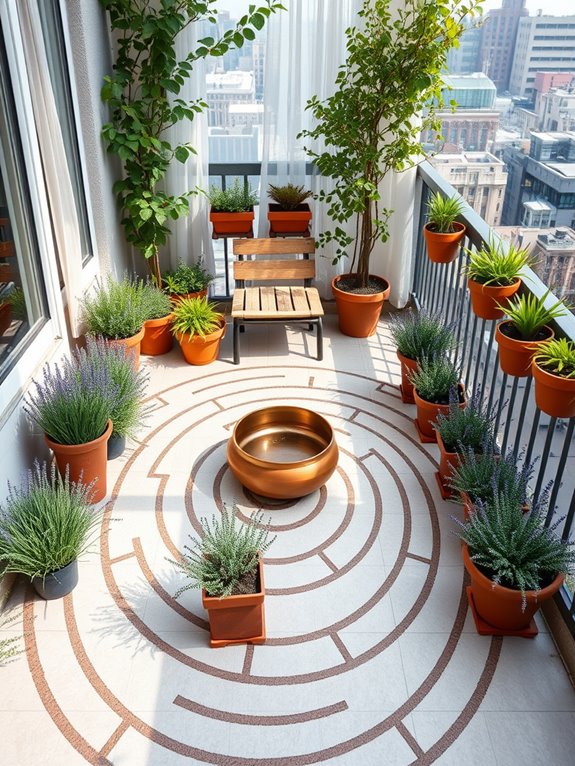
Creating a labyrinth garden is a meditative journey that begins with careful planning and precise execution. The winding paths, bordered by fragrant herbs like lavender and thyme, create an enchanting pattern that draws the eye inward while leading feet along a contemplative journey.
Natural stone pavers or brick pathways contrast beautifully with the lush greenery, while carefully positioned ornamental grasses add movement and texture to the design.
The spiritual essence of a labyrinth garden comes alive through thoughtful plant selection and strategic placement of focal points. Tall butterfly bushes and Russian sage create purple-hued walls that separate the paths, while creeping Jenny and moss soften the edges of walkways.
Centered within the labyrinth, a peaceful meditation area might feature a reflecting pool, stone bench, or sculptural element that serves as the journey’s destination.
Key Elements:
- Path-marking materials (stone, brick, or gravel)
- Border plants (lavender, thyme, sage)
- Tall screening plants (ornamental grasses, butterfly bush)
- Ground covers (creeping Jenny, moss)
- Central focal point (fountain, sculpture, or bench)
- Edge markers or lighting
- Landscape fabric
- Mulch or stone chips
- Grade-appropriate soil
The construction process starts with clearing and leveling the designated area, followed by marking the labyrinth pattern using string or spray paint. Traditional seven-circuit designs work well in spaces 25-40 feet in diameter, while smaller areas can accommodate three or five circuits.
Install landscape fabric to prevent weed growth, then lay the pathway material according to your marked pattern. Plant borders should be installed last, working from the center outward to maintain the integrity of the design.
Space constraints need not limit labyrinth creation – smaller spaces can utilize miniature versions with narrow paths and dwarf plant varieties. Consider vertical elements for tiny gardens, using climbing vines on trellises to create “walls” between paths.
In balcony settings, a painted or tiled labyrinth pattern can be created directly on the floor surface, with container plants marking key points along the journey.
Adding Plants and Garden Features
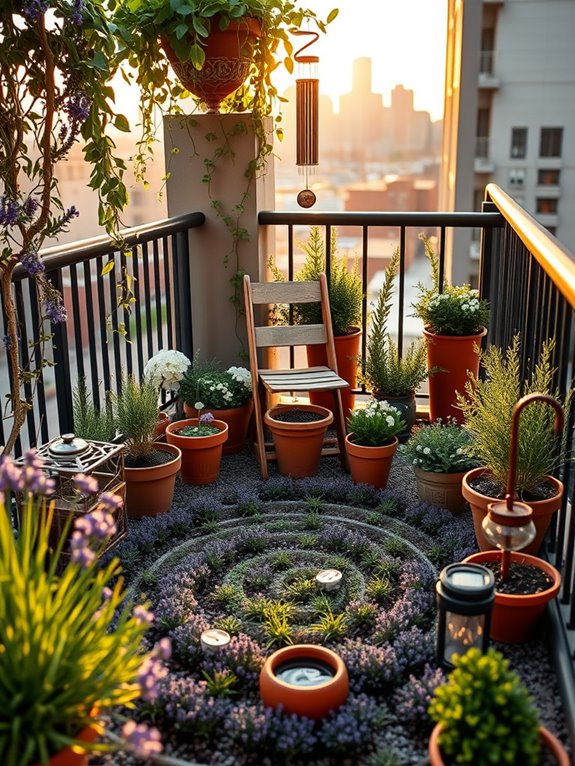
The mystical journey of a labyrinth garden comes alive through thoughtful plant selection and strategic positioning of garden features. Tall, flowing ornamental grasses like Miscanthus and Pennisetum create gentle movement along the pathways, while lavender and rosemary release aromatic scents as visitors brush past.
Stone sculptures, weathered benches, and copper wind chimes placed at key turning points serve as both navigational markers and meditation focal points, transforming each step into a sensory experience.
The heart of the labyrinth garden reveals itself through layers of texture and color. Climbing roses and jasmine adorn archways at significant transitions, while clusters of white-flowering plants like candytuft and moon flowers illuminate the paths during twilight hours.
Small water features create gentle sounds that mask urban noise, and carefully positioned mirrors amplify natural light while creating illusions of expanded space.
Key Elements:
- Ornamental grasses (Miscanthus, Pennisetum, Stipa)
- Aromatic herbs (Lavender, Rosemary, Thyme)
- Climbing plants (Roses, Jasmine, Clematis)
- White-flowering plants (Candytuft, Moon Flowers, White Echinacea)
- Stone sculptures or ornaments
- Weathered wooden benches
- Copper wind chimes
- Small water features
- Garden mirrors
- Path markers or stones
- Solar-powered path lights
Implementation begins with mapping out the labyrinth’s basic path structure, then positioning taller plants and structural elements at key turning points.
Install water features and permanent structures first, followed by larger plants and grasses to establish the foundational green architecture. Create planting pockets along the pathway edges for smaller herbs and flowering plants, ensuring adequate spacing for growth.
Establish a maintenance schedule that includes regular pruning to keep paths clear and plant heights appropriately scaled.
For smaller spaces or balcony adaptations, consider using container gardens with dwarf varieties of your chosen plants.
Vertical growing systems can maximize limited space, while miniature water features and smaller sculptures maintain the meditative atmosphere.
Focus on plants that perform multiple functions – such as herbs that provide both fragrance and visual appeal – and use lightweight materials that won’t overload structural limitations.
Consider incorporating foldable or movable elements to allow flexibility in the space‘s use and maintenance.
Maintaining Your Sacred Space
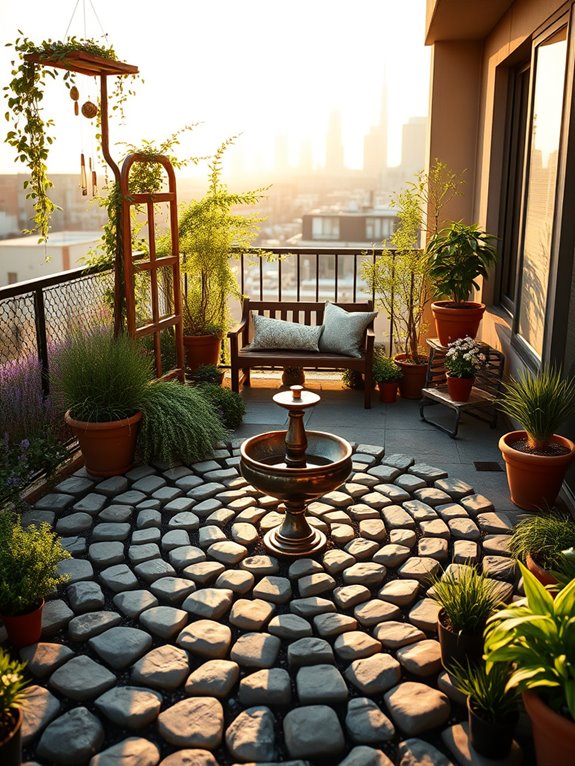
A sacred garden space anchored by a labyrinth becomes a living sanctuary where gentle pathways wind between beds of lavender, sage, and rosemary. The aromatic herbs release their calming scents with each step, while tall ornamental grasses sway gracefully along the borders, creating a sense of movement and privacy.
Stone benches nestled in quiet corners invite meditation, while wind chimes hanging from shaped arbors add gentle music to the peaceful atmosphere. Morning glories and moonflowers climb trellises strategically placed at cardinal points, marking the transitions between different sections of the space. A small central fountain or meditation stone serves as the heart of the labyrinth, surrounded by white flowering plants like sweet alyssum and candytuft that seem to glow in twilight.
Japanese forest grass and creeping thyme soften the walking paths, while carefully positioned solar lights create enchanting shadows after sunset.
Essential Elements:
- Curved or circular walking paths
- Meditation focal point (fountain, statue, or stone)
- Aromatic herbs and flowers
- Seating areas
- Wind chimes or bells
- Solar or low-voltage lighting
- Climbing plants and trellises
- Ground cover plants
- Privacy screens (natural or constructed)
- Water feature
- Sacred symbols or meaningful artifacts
Creating a sacred space requires thoughtful planning of both hardscape and plant materials. Begin by establishing the primary walking path using natural materials like gravel, stone, or brick, ensuring the surface is level and well-drained.
Position the central focal point first, then work outward, placing larger elements like benches and trellises before adding plants. Install irrigation systems and lighting before completing the planting, and consider incorporating symbolic elements that hold personal meaning throughout the space.
Regular maintenance preserves the tranquil atmosphere: trim herbs and grasses monthly, clean water features weekly, and refresh path materials seasonally. Prune climbing plants to maintain their shape while allowing natural growth patterns to emerge.
Consider installing a simple drip irrigation system to ensure consistent moisture for plants while maintaining the peaceful atmosphere undisturbed by manual watering.
For smaller spaces or balconies, create a modified sacred space using container gardens and vertical elements. Use lightweight pots for rooftop gardens, and consider fold-away seating to maximize space.
Incorporate mirrors to create the illusion of depth, and choose dwarf varieties of traditional meditation garden plants. Sound elements become especially important in urban settings, where wind chimes and small fountains can help mask city noise and enhance the sense of sanctuary.
